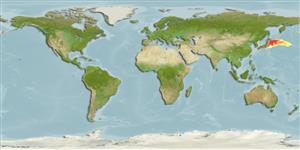>
Lophiiformes (Anglerfishes) >
Himantolophidae (Footballfishes)
Etymology: Himantolophus: Greek, himas or himantos = leather strap, thong or leash (referring to the thick leathery illicium) + Greek, lopho or lophio = crest or tuft (referring to the baited illicium projecting from the head) (Ref. 86949); borealis: From the Latin borealis meaning northern (Ref. 43997).
Environment: milieu / climate zone / depth range / distribution range
Ecologia
marino batipelagico; distribuzione batimetrica 1210 - ? m (Ref. 43997). Deep-water
Distribuzione
Stati | Aree FAO | Ecosystems | Presenze | Point map | Introduzioni | Faunafri
Northwest Pacific.
Size / Peso / Age
Maturity: Lm ? range ? - ? cm
Max length : 6.2 cm SL (female)
Short description
Chiavi di identificazione | Morfologia | Morfometria
Spine dorsali (totale) : 0; Raggi dorsali molli (totale) : 5; Spine anali: 0; Raggi anali molli: 4; Vertebre: 18. Distinguishing characteristics of metamorphosed female: short illicium 26-32% SL; distal escal appendage 22-24% SL, distal one-fourth to one-third of length bifurcated twice, darkly pigmented except for extreme distal tips; posterior escal appendage 4.8-7.1% SL, bifurcated distally; postolateral appendages 2 at base of escal bulb and distal appendage (Ref. 86949).
Males and larvae unknown (Ref. 43997). Minimum depth from Ref. 58018.
Life cycle and mating behavior
Maturità | Riproduzione | Deposizione | Uova | Fecundity | Larve
Kharin, V.E., 1984. Two new species of deep water anglerfish (Ceratiodei: Himantolophidae, Gigantactinae) from the North Pacific. J. Ichthyol. 24(3):112-117. (Ref. 43997)
IUCN Red List Status (Ref. 130435: Version 2024-1)
Threat to humans
Harmless
Human uses
Pesca: di nessun interesse
Strumenti
Special reports
Download XML
Fonti Internet
Estimates based on models
Phylogenetic diversity index (Ref.
82804): PD
50 = 0.5000 [Uniqueness, from 0.5 = low to 2.0 = high].
Bayesian length-weight: a=0.01995 (0.00906 - 0.04395), b=3.01 (2.83 - 3.19), in cm total length, based on all LWR estimates for this body shape (Ref.
93245).
Trophic level (Ref.
69278): 3.7 ±0.6 se; based on size and trophs of closest relatives
Fishing Vulnerability (Ref.
59153): Low vulnerability (10 of 100).
